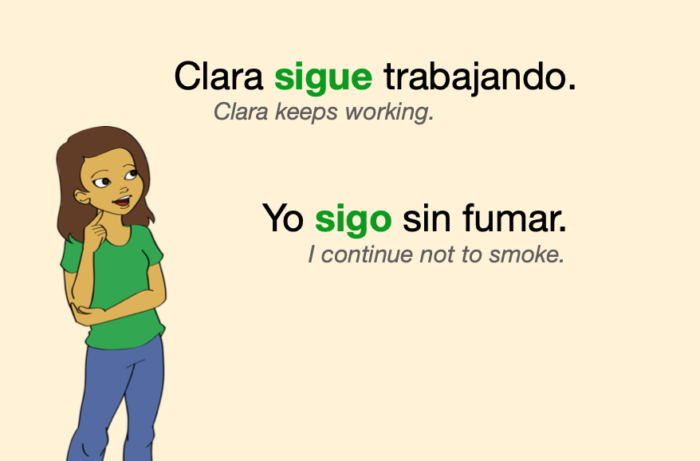Welcome 😊 to our grammar lesson on the Spanish verb seguir.
seguir has two basic meanings:
- In some sentences, it means to continue, to go on, to keep doing something…
- In other sentences, it means to follow

By the end of this lesson, you will be able to use the verb “seguir” in sentences.
You will also find a Quiz and Exercises to practice.
Contents
Conjugations of “seguir”
First, let’s review the conjugations of “seguir” in a couple of tenses: the Present and the Preterite.
“seguir” is irregular in both tenses, because the letter i replaces e for some persons:
| Present | Preterite | |
|---|---|---|
| yo | sigo | seguí |
| tú | sigues | seguiste |
| él | sigue | siguió |
| nosotros | seguimos | seguimos |
| vosotros | seguís | seguisteis |
| ellos | siguen | siguieron |
“seguir” meaning “to continue, to keep…”
When “seguir” means to continue, to keep…, it produces the following grammar structures:
“seguir” + Gerundio
To express that something continues to happen, is still happening… we conjugate seguir in whatever tense we need, followed by another verb in Gerundio form:
Mi tía sigue fumando.
My aunt keeps smoking.¿Vosotros seguís comiendo?
Are you guys still eating?Clara sigue trabajando.
Clara is still working.Nuestros huéspedes siguen durmiendo.
Our guests are still sleeping.El jugador siguió marcando goles.
The player continued to score goals. (“siguió” is Preterite Tense).Ella ha seguido hablando.
She has continued talking. (“ha seguido” is Present Perfect)
Remember…
The Gerundio of regular verbs in -ar ends in -ando.
The Gerundio of regular verbs in -er and -ir ends in -iendo.
Some verbs have an irregular Gerundio. The most important irregular ones are:
decir → diciendo
dormir → durmiendo
morir → muriendo
pedir → pidiendo
venir → viniendo
leer → leyendo
oír → oyendo
ir → yendo
Click here to learn all about the Gerundio, and more irregular Gerundios
“seguir sin” + Infinitive
To express that something continues NOT to happen, is still NOT happening, we conjugate seguir in whatever tense we need, followed by sin, and then another verb in the Infinitive:
Yo sigo sin saber la dirección.
I still don’t know the address.¿Sigues sin hablar con él?
Are you still not talking to him?Nosotros seguimos sin entender la lección.
We still don’t understand the lesson.Él siguió sin trabajar tres años más.
He continued not to work for three more years. (“siguió” is Preterite Tense)
“seguir” without any other verb
Sometimes we use seguir by itself, without any other verb:
¿Sigo con esto?
Do I continue with this?Sigue, por favor.
Continue, please. (Affirmative command).Tenemos que seguir así.
We have to go on like this.
For example, we often use “seguir” without any other verb when we give directions:
Sigue todo recto.
Keep going straight ahead.Sigue hasta el semáforo y luego gira a la derecha.
Continue until the traffic lights and then turn right.
“seguir” meaning “to follow…”
seguir can also mean to follow:
Yo sigo las reglas.
I follow the rules.Ellos siguen mis pasos.
They follow my steps.
When the thing that’s being followed is a person or a moving object, we need the preposition a after seguir.
Sigue a ese coche, por favor.
Follow that car, please.Nosotros seguimos al líder.
We follow the leader.
Practice
Quiz
Take this short Quiz about the verb “seguir”:
Exercise 1
Fill the blanks conjugating “seguir” in Present Tense. Click on the gray spaces to see the solutions:
1) Yo sigo aprendiendo español.
I keep learning Spanish.2) Ellos siguen sin fumar.
They continue not to smoke.3) Nosotras seguimos practicando.
We keep practicing.4) Vosotros seguís meditando dos veces al día.
You guys keep meditating twice a day.5) Tú sigues sin comprender el problema.
You still don’t understand the problem.6) Mi padre sigue haciendo la cena.
My father is still making dinner.
Exercise 2
In the following sentences, the verb “seguir” is already included.
We need to conjugate the verbs in brackets, either in the Infinitive or in Gerundio:
1) Tú sigues siendo mi persona favorita. (ser)
You are still my favorite person.2) El niño sigue sin hablar . (hablar)
The child still doesn’t talk.3) Vosotras seguís durmiendo . (dormir)
You girls are still sleeping.4) ¿Tú sigues sin beber alcohol? (beber)
You still don’t drink alcohol?5) Yo sigo trabajando en mi proyecto. (trabajar)
I’m still working on my project.6) Nosotros seguimos sin tener respuesta. (tener)
We still don’t have an answer.








